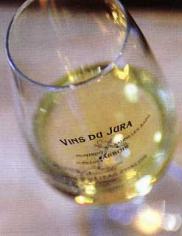Château Chalon, is not really my style of wine, nor even close. A protective blanket of yeasts or voile that rests on top of the wine, while partly protecting it at the same time allows oxidation and it imparts a strange nutty, salty character. This element gives these wines a difference and sets them apart from ordinary wine. From my standpoint, I am extremely sensitive to the slightest oxidation that occurs in open wine that is coming down from its peak, and over-oxidation would, well . . . turn me off, altogether. I remember vaguely that my first encounter with this type of wine was in a Michelin-starred restaurant in the Franche-Comté, while traveling from France to Switzerland, and I believe, the second experience was when I dined over a period of time at the restaurant Chez Maitre Paul, 12 Rue Monsieur Le Prince, Paris, where I enjoyed a chicken with a sauce made with vin jaune. When I first ordered a bottle of the local wine the waiter warned me that most customers, including his French guests, did not enjoy these wines. They are different he stressed.
Why then am I writing about it? And why are sommeliers and others in the trade going bonkers for it? This is because they are different and that is in itself is interesting even though, these wines are not my personal favorites. However, no matter what I think; there is a source for them by following this link: http://www.chateauchalon.com/ also note that they have quite an excellent selection of Absinthe at this page: http://www.absintheclassics.com/ In addition you can take a look at my previous post about absinthe: http://restaurant.kitmarshal.site/wp-admin/post.php?action=edit&post=81
The wine comes from a minuscule appellation in France’s Jura region devoted to the production of vin jaune. It is a grape that turns deep yellow as it ages for years in wooden barrels that are filled only partway. The oxygen that gets into the barrels would turn most wines to vinegar, but vin jaune survives due to the aforementioned voile. It is illegal to be imported into the United States due to the odd-sized bottle, which is only 620 ml. The illegal part is the short, squat bottle traditional to the area that holds only 620 ml. In the U.S., and only standard bottle sizes, such as 375ml, 750 ml and larger (magnum, jeraboam etc.), are recognized. and unfortunately, not 620 ml.
“Jean Berthet-Bondet is a producer of these wines made in an oxidized style, although not all of his wines are made in this way; it turns out that he also makes a bright, yeasty, mineral-laden Chardonnay and a sharp, light red from a blend of the local Trousseau, Poulsard, and Pinot Noir, both of which are entirely legal. He also makes a blend of Chardonnay and Savagnin that is aged for just two years or under and tastes like salted caramel. These wines go well with smoked fish, or white meat in a cream sauce and also with dishes made with frogs, as they have an abundance in Franche-Comté.”
The Franche-Comté is called the Jura often as not, and the two names are used interchangeably. This is the land of Gruyère cheese, and the people of the Jura were making it centuries before the Swiss were. It is a Herculean job but it is worth the effort, for when they finally wrench it from the earth, they have the gentian root, an aromatic substance which, distilled, forms the basis for many a liqueur and apéritif including the popular Suze. Absinthe plants abound in these hills, also, and it is not surprising to learn that this is the home of Pernod. The banks of those lakes and streams are inhabited with frogs. Frogs’ legs are a subtle delicacy awaiting in many country inns. There is also fish stew, filled with undertones of flavor—white wine, herbs, spices, small onions, and mushrooms. Called i matelote, a pochouse, or a meurette, it doesn’t matter. He should have subtlety, savor, and seductiveness. Tench, carp, perch, eel, and pike will all contribute to his happiness. And there are a dozen of dry white wines of the province to act as companions.
“Château Chalon is only for special occasions”, Mr. Berthet-Bondet says. “There simply isn’t much of it with only 136 acres specified for its production. And it takes ages for the wine to realize its full potential”.



